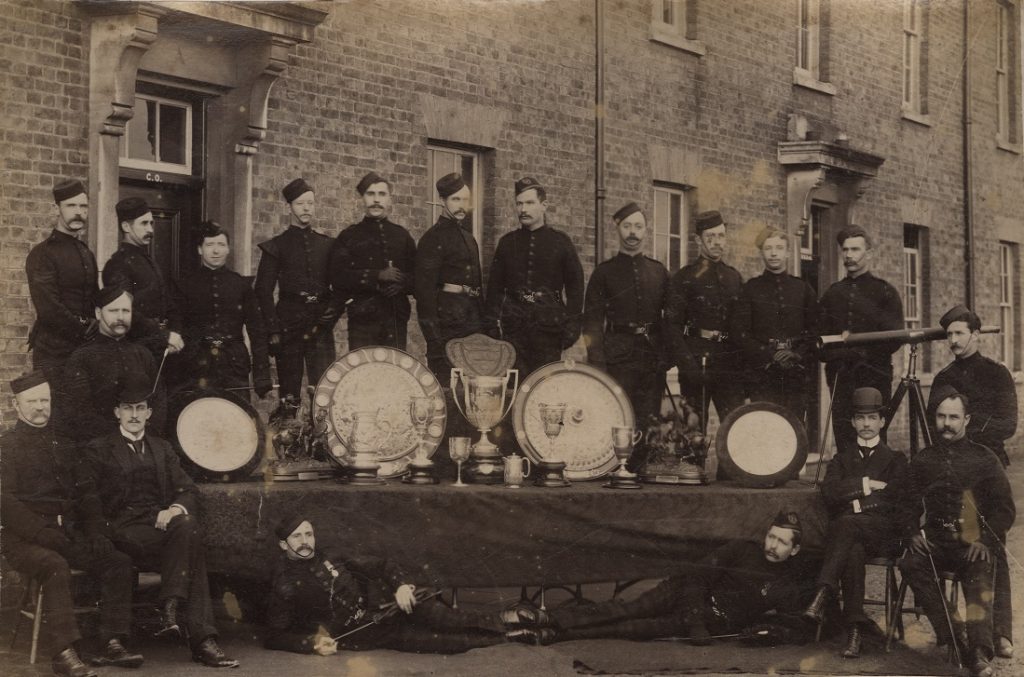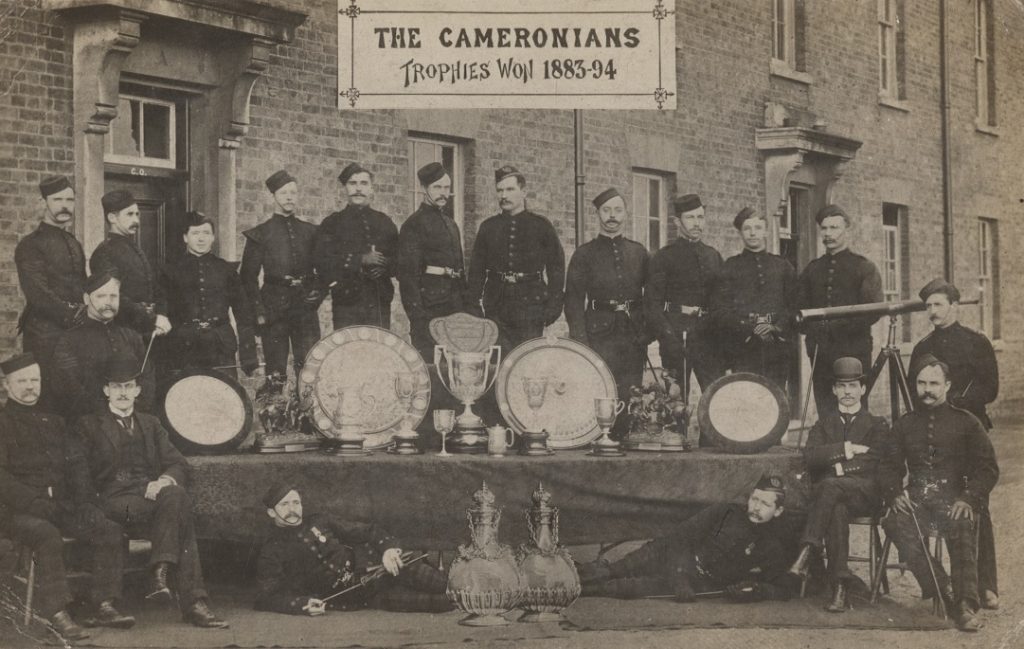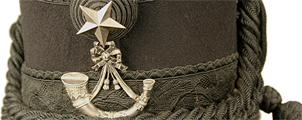Cameronian scoops top prize at Bisley
This fascinating photograph is contained within an old album in the regimental collection. It shows Private Brown of B Company, 1st Battalion The Cameronians – winner of the Imperial Prize competition at Bisley in 1894. The rather impressive silverware next to him are the challenge vases awarded as part of the prize; the other part being a personal cheque of £100 – a fair old sum for a Private soldier in 1894! Brown’s left hand rests on the stock of his Lee-Metford rifle with which he secured victory, and the honour of being forever immortalised in the records of his Regiment.

Private Brown, winner of the Imperial Prize at Bisley, 1894
The entry in the regimental Digest of Service for 1894 records that:
“The Battalion gained a large number of Prizes at the Browndown Rifle Meeting. At Bisley, the Imperial Prize which was open to Officers, N.C. Officers & men of the Regular Army was won by Pte J. Brown of the Battalion, who secured himself £100 & a pair of very handsome Silver Challenge Vases which were placed in the Officers Mess.”
1894 was the first year the Imperial Prize was competed for at Bisley, the home of British competition shooting since 1890. The Imperial Prize was competed for over two days of shooting. On the first day, competitors were allowed seven shots at targets placed at 200, 500, and 600 yards distance. Once the points were tallied, the top 100 progressed to the second and final day of shooting, comprising of 15 shots at a distance of 800 yards.
Newspaper reports from the time record that the weather over the two days of shooting was far from ideal, with heavy rain and high winds. At the end of the 500 yards stage of the event, the two highest scorers were a Lieutenant of the Scots Guards, and a Sergeant of the Northamptonshire Regiment. A good round at the 600 yards target saw Private Brown of The Cameronians in contention for the win, in what turned out to be a very close final round:
“The contest virtually lay between Col.-Sergt Phillips, Sergt.-Major Brown, and the winner. The sergeant-major finished with 152, at which time Private Brown had 148, and two shots to go. His fourteenth was a bull. He took a long aim for his last, and as the signal from the target was some time in making its appearance it was thought he had missed. A cheer was raised when a bull was signalled.”
Edinburgh Evening News, 13th July 1894
Private Brown won the competition with a score of 158, five points clear of the runner up, Captain Cowie of the Royal Engineers. Described in one newspaper account as a ‘young’ soldier, Brown was almost 40 years old when he won the Imperial Prize, and had originally joined the 90th Perthshire Light Infantry, an antecedent regiment of The Cameronians (Scottish Rifles), in February 1874. The article from the Edinburgh Evening News closes with the remark “Up to this year the winner had not been an abstainer from ardent spirits, but he is, and has been all this year, a teetotaller.” This somewhat curious statement takes on new meaning when one examines Private Brown’s service record. Born in Londonderry, John Brown enlisted for service at Hamilton on 28th February 1874, aged 18 and 6 months. He had previously been occupied as a Labourer. Brown’s military service got off to something of a rocky start when, after only five months service, it was discovered that he had neglected to mention he was actually enrolled in the Londonderry Light Infantry militia at the time of his enlistment with the 90th. There follow a number of instances of imprisonment by order of the Commanding Officer, until September 1876 when Brown is transferred to the 73rd Regiment (another Perthshire regiment). Whether this transfer was at his own request, or by order of the Commanding Officer of the 90th, is not recorded. The transfer did, however, mean that Private Brown would miss active service with the 90th in South Africa (1878-1879).
While with the 73rd, Brown continues to appear before his Commanding Officer resulting in further spells in prison, and numerous instances of loss of Good Conduct Pay. Despite his frequent clashes with regimental authority, Brown is permitted to extend his period of service to 12 years ‘with the Colours’ in July 1879. This would suggest that, while numerous, the nature of these ‘crimes’ were not serious enough to warrant discharge and were probably related to drunkenness.
Brown re-joined the 90th Perthshire Light Infantry on 30th September 1880, remaining with it through it’s transition to become the 2nd Battalion Scottish Rifles following the amalgamation with the 26th Cameronian Regiment in 1881. The cycle of ‘Awaiting Trial’ followed by ‘Imprisoned’ along with the occasional ‘Forfeiture of Good Conduct Badge’ continue until early 1894. A spell of good behaviour sees his first Good Conduct Badge restored on 28th February 1894, followed by a second on 30th August of that year. If the newspaper article quoted earlier is to be believed, we might assume that this period of improved conduct is a result of Private Brown’s newly found sobriety. Whether this change in personal circumstance also led to Brown’s success at Bisley can only be guessed, but we can assume that he had already demonstrated some skill at musketry before winning the Imperial Prize. This photograph is from another album in the regimental collection and is captioned simply as “Shooting Trophies – Aldershot – 1891-1893”:

Private Brown is standing in the back row, fifth from the right. His appearance in this photograph might suggest he was already an accomplished marksman and may have indeed contributed to the securing of one or more of the prizes on display.
As the above photograph demonstrates, The Cameronians were not unused to success in competitions of shooting and musketry. In 1893, the 1st Battalion had taken 1st and 2nd Prize in the “Evelyn Wood Competition” at Bisley; a group event focused on a mix of marching and shooting. Still, winning a competition as grand as the Imperial Prize was something worth celebrating:
“Private Brown, of the Cameronians, who won the Imperial Cup at Bisley, returned to Portsmouth, where his regiment is quartered, on Saturday night, and met with a right royal reception… A telegram was received by the regiment during the evening from Sergeant-Major Brightman that the winner would arrive by the 9.43 train. Accordingly a waggonette, with the regimental band and pipers, was at the station to receive him. The news had got abroad, so that besides his comrades there was a large crowd ready to meet the successful marksman. The train was about an hour late and when it did draw up at the low level platform there was an enormous crowd awaiting it. On emerging from his compartment, Brown experienced an enthusiastic reception, and the crowd and his comrades carried him amid ringing cheers to the waggonette, while the band struck up “See the Conquering Hero Comes.” The cups were carried by Sergeant-Major Brightman and Sergeant-Instructor Jennings. On reaching the barracks Brown was escorted to the Officers’ Mess, where he was received by the officers, who complimented him heartily on his success.”
Hampshire Telegraph, 28th July 1894
Further evidence of the Battalion’s pride in securing the Imperial Prize is demonstrated by the above photograph being published as a postcard by the Battalion in 1894, with the addition of some recently acquired silverware!

Postcard published by The Cameronians in 1894. The challenge vases won as part of the Imperial Prize have been super-imposed in front of the display of silverware won by the Battalion.
Following the restoration of his Good Conduct Badges in 1894, there are no further reprimands or reductions logged in Private Brown’s service records and he was finally discharged from the 1st Battalion The Cameronians (Scottish Rifles) on 30th March 1895, with 21 years and 34 days service under his belt. Of this, 19 years and 251 days would count towards his pension – bad behaviour comes with a cost after all!
Comments: 1


